Tomato planting was all that easy before, as believed by many. The good produce of traditional planting has never been refuted until one company introduced their Topsy-Turvy Tomato Planter. This particular innovation was recognized by Time Magazine as one of the Amazing Inventions in 2005. The basic principle behind this product is to do away with the conventional tomato planting by hanging it to save space and turn it upside down to let the water and nutrients go down directly to the leaves and fruits without much effort. Well, to point out exactly the advantages of this product, here are the following benefits you can possibly have:
1. Easy start. You can have your tomato plant hang in your veranda almost instantly. All you need to have is topsoil and a starter tomato plant to relocate to the Topsy-Turvy Planter. And, boom! There’s your tomato plant.
2. No more stages and cages. By keeping it upside down, it enables the stem to just hang. That means staking will not be necessary, nor the caging, since it is already off the ground.
3. No bend-overs. Planting tomatoes while standing is now possible since Topsy-Turvy designed it to be hanged. It means you can water the plant by just standing straight. No more weeding and no more worm attacks. So, grannies, this gardening product is of your advantage.
4. Recycle. This plant container is said to be environmental friendly since this can be recycled from one plant to the other.
5. Double it. With this gardening tool, you can’t just limit your container with one tomato. You can double it. By this means, you can maximize the number of tomatoes you can reap in every harvest season.
The success of this method has given indoor gardening a breakthrough. But to some, it’s just a mere disappointment. 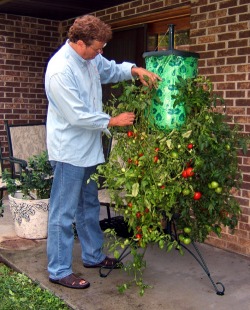
There were claims that Topsy-Turvy Tomato Planter is but another added pile of junky in their warehouses. Most claims are contradictory to the above mentioned advantages in using this particular product. Here are some common grievances:
· It is too weak to carry the entire tomato plant. It can’t even reach a single harvest period as tomatoes grow heavier each week. Not even the two-in-one design where there are two tomato plants in one container supposedly. But the problem was still the same. It is not durable.
· Some still believes in the conventional way of planting tomatoes. They could not entertain the idea to defy natural way nutrition transportation of plants – the roots should be going down while it is growing, not the other way around.
Though the disagreement may come mostly by opinions, satisfied users have also expressed the upsides of this gardening product. As of now, its popularity is still in its hype. As long as you think the innovation can hold true to its purpose, it’s worth trying.
Did you ever wonder how nutritious your veggies are from the market? Or was there a moment in your life when you thought of how fresh ‘fresh vegetables’ are? Or how long should it be stored before it could still be considered fresh?
If you are considering the idea of gardening vegetables in your backyard, nutrients and freshness will not be an issue for you anymore. Aside from that, you may be surprised of the possible savings that you will have and the therapeutic effect of sowing and reaping your own plants. It might also be a good venue to draw your children closer to you and nature, giving them enough room for learning green practices instead of green jokes.
Anyway, there are a lot of veggies that you can plant within your backyard. And believe me, even within the context of gardening, size doesn’t matter. Aside from the physical size of your backyard lot, the size of your garden is dependent on the available time that you can give to your garden. No matter how wide your area for gardening and yet you can’t spend a single minute for it everyday, then you better cement your backyard and design a basketball court on it.
So, if you are ready, you can check these items before starting your backyard plantation to refrain from common mistakes the rookie home-veggie-farmers often miss:
1. Size
Know exactly the size of your backyard and how much area you can utilize for veggie planting. After that, you can move on to plan for the type of plants and how many of those will you plant for each respectively.
2. Landscape
Find out the slope of your backyard. It must be levelled to maintain even distribution of water and to avoid erosion in times of rain or regular watering of the plants.
3. Vegetables
Knowing what to plant and knowing the number of specific veggies to plant will help you decide on the number of beds to make. To save space in your backyard, you can put the same veggies in the same bed. Consider also the distance between beds to put some pathways.
4. Soil
Know the pH of your soil. The best pH according to experts is 6.5. With this number, the nutrients can be easily dissolved, thus making it easy to distribute to your plants.
5. Schedule
As seasons change, you should change your veggies, too. This way, you will not waste your time in planting the wrong veggies at the right time. Know when to start planting and what kinds of veggies are ideal for a certain season, especially during winter. There are plants which can’t tolerate cold. Also, keep notes of your grown plants in each bed so that you can have a reference for your future plans in improving your vegetation.
6. Equipment
Gardening equipment, gardening accessories, and other gardening products should be appropriate to your kind of garden. I think it’s a bad idea if you have huge rakes for your small beds, right?
After checking these items, you can proceed to your planting. Just always remember that starting your veggies from your own backyard requires extra effort. But by the time your veggies are ready for reaping, the feeling will always be rewarding. You have saved money. You have developed a green and healthy routine inside your premises. With the correct practices, you have ensured freshness of your vegetables and you are secure of the proper nutrients of your veggies. What else could you ask for?
Gardening is a form of leisure that can be done not only on your wide farmlands and small backyards but also inside your own homes and offices. It is a favorite pastime for housewives, grannies, and young people who have green thumbs. Actually, some of the enthusiasts turn it into business. As plants are commonly known to be dependent on sun’s rays, the common question among new recruits is ‘How about during winter?’
As I’ve said, gardening is not an exclusive outdoor activity. And since indoor gardening is applicable, plants that can be grown indoors is not a problem at all. There are hundreds of indoor plants you can choose to grow and serve as an ornament in your interior. Below are the lists of the most wanted plants that are easy to grow and easy to care for while resting on the beautiful corners of your house:
 1. Aloe vera
Aloe vera is one of the easiest plants to grow and requires the least amount of attention. Yet, it has the slowest pace in terms of growth.
If you are wondering if this is the same plant that is the source of herbal components for shampoos and lotions, this is exactly the one. Other types of aloe vera are even used for intakes like the tea and other forms of beverages.
But what is amazing is that this type of indoor plant is nice to blend with other ornamental plants. From few inches up to a foot tall, this can be a great decor along with the other plants because of its attractive flowers.

2. Bamboo
Be realistic. Don’t think of those bamboos which are 20 feet tall that are found in the wilds which pandas are feeding. These kinds of bamboos are ornamental of course. Commonly known as the ‘lucky bamboo’, these types can be found in Africa and Asia which grows in rainforests.
This charmed plant is planted in a container with regular water replacements. Usually, pretty stones are added around it for beautification. It can live even during winters as it survives dark regions as part of its unusual characteristic. Hence, this is the reason why this particular plant is growing inch by inch in terms of popularity among hobbyists.
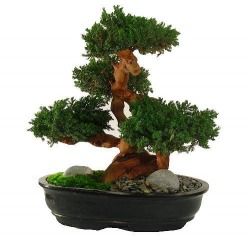
3. Bonsai
Bonsai plants are known to be the cutest tree ever. With so much art incorporated in this miniature plant, the minute details for ornamental purposes are very impressive. Sometimes, there are misconceptions on bonsai as dwarfs. But scientifically speaking, they do not involve genetic processes to produce little versions of big trees. It’s just a matter of cultivating skills.
For indoor gardening greenhorns, they buy bonsai plants which are already grown and trimmed. But for some, they wanted it to grow for themselves - that is from seedlings to shaping. Bonsai also needs to be watered and fertilized regularly but not that incessant. Thus, this makes it cuter.
These suggested indoor plants are considered few of the best choices that you can have in your private homes or public offices. Depending on your personal preference, ornamental plants make your dream come true as an indoor gardener and, maybe, an interior designer as well.
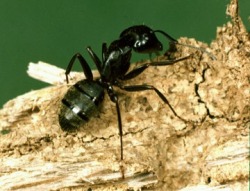 Carpenter Ant Ants are tiny insects which can sting your foot off when you walk barefoot in your garden or even inside your house. As there are many types of ants that are found in homes and buildings, it might not be that easy to identify considering their size, which ranges from 3/8 of an inch to 1 inch, and their color, which are mainly black and red. In fact, even carpenter ants can hardly be recognized from its other relative ants.
First, let us try to distinguish carpenter ants from other ants. Carpenter ants have unique features that differentiate them from others such as their single node and a rounded upper surface thorax. Although some ants may look almost the same as carpenter ants, the thorax is most likely to be noticeable. Since they are classified as insects, they are believed to be harmful to woods just as some termites do. But these types of ants don’t eat wood though they reside and nests on it.
Just like the typical ants, they are classified into three social distinctions – the queens, the males and the workers. The queen usually spends most of the time in their nest for safety while those which you can see often are the workers. The male ants are generally those with huge heads, enormous eyes, and large thoraces, with wings, which after mating will die the soonest. And did you ever wonder where their female counterparts are? Well, they are the workers.
Talking about wings, carpenter ants have different wing composition than that of a termite. The termite’s has equal length on front and back wings while the carpenter ant’s has shorter or smaller back wings than those pair in front. But the very obvious dissimilarity is that termite avoids light thus making it less visible outside their colony while winged carpenter ants can be seen almost constantly away from their colony. Furthermore, winged termites have light colors while flying carpenter ants possess darker ones. Also, the former has straight antennae while the latter has bent antennae.
And did I mention about their diet? I mentioned about these ants not eating woods earlier. Well, they just favorably live in it because they feed on sweets. Carpenter ants which are found inside buildings feed on meats, sugar, honey, and the like. But those who are living outdoors nourished on dead insects which produces sweet juices such as aphids and other fruit-tree-sucking creatures.
Now, as they live in woods, it is apparent that they can be harmful to the wooden structures in homes and buildings. This is why we have distinguished carpenter ants from any other ants and termites for this is very significant in controlling pests – to know who you are dealing with. Carpenter ants reside on damp woods and rotting trees which are explicitly exposed to moisture, condensation or poor ventilation. Now these deteriorating woods are more prone to extreme damage due to carpenter ants’ tunnel-making and excavation activities. And this could worsen as colonies stay long within the area as they do diggings while they are still alive.
Exterminating carpenter ants would mean extraneous effort in finding their nests. Though they might be easier to find during summers, maybe it would take professionals to totally eliminate the dilemma caused by these insects. They might be harmless at an instant but could cause severe damage in the long run.
Ants are sometimes (or can always be) annoying. Killing ants inside or outside your home would seem like a child’s play. Those things we do to them when we were seven? They are actually practiced by grownups. The only difference is that no one could ever dare stop them from killing those tiny culprits - from pouring hot waters to breaking their single piles and torturing the flying ants by plucking their wings off one by one. Because of this, here are some effective styles in exterminating those irritating insects inside your house or on your backyard:
1. Maintain cleanliness
First things first. As most people say, prevention is better than cure. So, as ants feed mostly by leftovers over our plates, unwashed dishes on a kitchen sink, and dead insects lying around your backyard for quite some time, thus, it makes cleanliness the proper way of preventing attacks from these minute workers. Without possible food to take within your vicinity, the chances are so slim that these ants will be on your window jams and leaked walls. Washing the plates immediately every after dining makes a good practice in doing away ants. Cleaning the dining table and leaving no skids of juices and sodas is also advisable.
2. Murder the queen
Unlike Queen Elizabeth, the ant queen isn’t the virgin kind. She is somewhat the mass producer of workers in a colony. Killing the source is a vital move. Hence, there will be no more production of ants and the rest of the colony will be history.
By the way, queen ants can be found in the nests. They are the type which are anti-social. Or perhaps, shy. Unlike, again, Queen Elizabeth.
3. Snipe the messenger
Ants have this tactics where a single worker is sent to find possible food source. After a successful mission, the said ant would then return to the colony and announce the good news, ‘We have food!’ So, the workers then will go to the area where their prospected food lays and carry it over to the colony. With this method, you can easily kill the solo ant so that there will be no news for the colony which could lead to exodus.
4. Secure the area
Apart from cleaning the table, the plates, and the kitchen, your food containers must be an air-tight type. This way, ants could not penetrate to your containers and there will be no food for them for the rainy days. Plus, your food is more secure from spoiling immediately.
Also, seal the leaks on your walls where ants could possibly find its way inside your premises. Fasten also the corners of your wall and floor to cover up their possible point of entry.
5. Fire in the hole
This approach is the most exciting one. Actually, this can better be called the genocidal approach. This is how it works: boil an enough amount of water and pour it on the nests. This is where the genocide comes to the picture. Simple.
However, the only thing that you must consider is that you have to locate first the nest which requires extra effort. But, well, not that time consuming. All you have to do is follow the pile of workers to where they will store their food. And, viola! Mission accomplished.
There are still a lot of ways in killing ants. But these methods mentioned above are so far the best way since it will not require you to spend a lot of money and consume a huge amount of time.
|

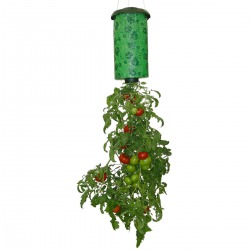
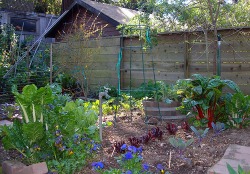




 RSS Feed
RSS Feed